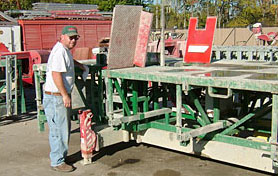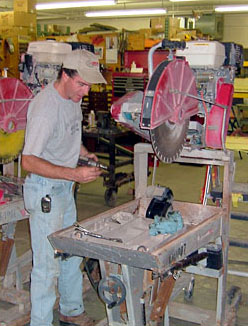Staying Up and Running
By Brett Martin
 Few things are more aggravating for mason contractors than equipment breakdowns. They hold up production, jeopardize deadlines and cost money.
Few things are more aggravating for mason contractors than equipment breakdowns. They hold up production, jeopardize deadlines and cost money.
"A machine down stops the crew and can cost thousands of dollars a day," says Joel Guth, CEO of Masonry Technology in Moreno Valley, Calif. "Then you might have to eat up more time going to get a rental."
When breakdowns could have been easily prevented, they're even more frustrating. That's why successful contractors don't wait for their equipment to fail before making repairs. They institute preventative maintenance and inspections programs that detect problems before they occur.
"If you buy good equipment and maintain it the way you're supposed to, it will last longer," Guth points out. "We have rebuilt mixers that are still running fine after 12 years."
Heading Off Trouble
Ask mason contractors the secret to keeping equipment up and running and they'll cite the same formula ? comprehensive maintenance coupled with regular visual inspections.
"Preventative maintenance will prolong the life of the machine more than anything," says Michael B. Adams, president of WEB Equipment, a Fredericksburg, Va.-based company that services more than 200 forklifts. "Not providing the maintenance is the number one reason why they suffer a breakdown."
For forklifts, a basic service that includes changing all of the filters and greasing the machine should be performed every 200 hours, Adams says. It takes four hours and costs $425. A full service should occur every 600 hours. It encompasses everything in the basic service, plus draining and replacing fluids, such as transmission fluid and oil in the wheel hubs. The full service takes six hours and costs $695.
Warren Townsend, yard manager for Davenport Masonry Inc. in Holt, Mich., says his company schedules maintenance on its 30 to 40 mixers every 50 hours. The service involves changing the gear casing oil, which costs $20.
"We haven't had gear casings go down in the field since we started that," he says. "It's a good return on that investment."
John E. Dolce, president of J.E. Dolce and Associates, a Roseland, N.J.-based consulting firm, and author of three books about fleet maintenance and management, suggests a 30-day inspection cycle. Equipment is inspected every 30 days, allowing contractors to assess whether it will break down before the next inspection. If it will, then repairs need to be made before it goes to the job site. If everything will hold up for 30 days, then it's ready for work.
The same philosophy holds true for seasonal equipment. Dolce recommends inspecting machinery before the busy summer season. If it'll last through the summer, it's safe to hold off on replacing parts. If it won't, then the equipment should be repaired before the season gets underway.
When putting equipment away for long periods of time, inspect it before it goes into storage, Dolce says. Inspect it again 30 days before it's needed.
Even equipment as straightforward as scaffolding needs servicing. Jerry Castle, president of Bennu Parts & Service, as well as Jerry Castle and Son Hi-Lift Inc. in Elk Grove Village, Ill., says hydraulic scaffolding needs a daily inspection, but it only takes 10 minutes.
"You have to check the motor every day," Castle says. "And make sure the scaffolding is level and plumb and the safety mechanisms are in place."
Making Equipment a Priority
 With busy schedules and tight deadlines, it's easy to push machines to their limits and postpone servicing. It can be a costly mistake, which is why experienced contractors make equipment care a priority.
With busy schedules and tight deadlines, it's easy to push machines to their limits and postpone servicing. It can be a costly mistake, which is why experienced contractors make equipment care a priority.
As Brad Kirkpatrick, a mechanic with J. & E. Duff Inc. in West Chicago, Ill., points out, once the owner and job site foreperson make equipment maintenance a priority, it trickles down to all the employees.
"If your foreman is saying, 'Have you greased the machine and checked the oil?' then the guys realize if it's important to the foreman, it's important for them," Kirkpatrick says.
One business owner who stresses the importance of maintenance is Masonry Technology's Guth. He requires employees at each job location to conduct a daily equipment check, then send him a signed report.
Guth's track record lets employees know where he stands on keeping equipment in prime condition. He has terminated workers who failed to take care of equipment, such as the former employee who ruined a forklift by running it while it was low on oil.
"This is serious. If you don't spend money on maintenance, you'll spend it on repairs," he says, adding that because masonry equipment is often dirty and looks old, employees tend to neglect caring for it. "When people look at equipment, they don't look at the money behind it."
The main obstacle to making repairs and conducting inspections is time.
"You're getting pulled from both directions. You need the equipment on the site, but you need to bring it back into the shop for maintenance," Guth says. In those situations, he switches out equipment, even if it means renting machinery, to make sure the maintenance plan is followed.
Some contractors perform the maintenance right on the job site.
"Almost all of our servicing is done in the field," says Kirkpatrick, who spends 40% of his time on job sites. "The urgency is to keep the guys in the field working." For major repairs, such as a broken gearbox, leaking seal or crack in the framework, the equipment is brought back into the shop.
Training for Everyone
Not only should employees understand the importance of maintenance, they should actively participate in it. Dolce says business owners need to train employees how to inspect equipment and perform maintenance. Employees should know what the owner considers acceptable and what the owner considers in need of replacing.
"The training is literally a formal training. It doesn't have to be in a classroom, but show them what to do. Teach them, and see if they're receptive to the training," Dolce explains. "For a good preventative maintenance program, you list all of the things you want inspected and what the thresholds for inspections are."
If the equipment is outsourced for maintenance, the vendor needs to fully understand the owner's expectations, he adds.
When buying new equipment, especially something with new technology, owners should include training for their mechanics and operators as part of the purchase agreement, Dolce says. They should negotiate hands-on training to take place at the time of purchase, at six months and at one year.
"Partnering with the vendors is part of the process," he says.
Castle says he provides forklift training to customers so they can inspect the equipment. The training benefits both parties.
"We've trained customers so when they see 200 hours approaching, they need to call for service," he says. "You can get 8,000 to 10,000 hours on a forklift if it's properly maintained. That is a big plus."
Employees also want equipment to run correctly, so they have a stake in learning basic maintenance procedures, says Kirkpatrick, who trains operators how to inspect and service equipment. "It's just a matter of the guys taking pride in their work, and part of their work is maintaining the equipment," he says. "The equipment is kind of like, not necessarily the lifeblood, but the hands and feet of the job. Without the equipment, things shut down very fast."
Guth agrees that employees want to avoid equipment failures.
"It frustrates them as much as it does us," he says. "They want good equipment so they can get the job done."
Having reliable equipment builds strong employee-employer relationships. Townsend says workers appreciate the company making sure equipment is working properly before it leaves the yard. Even something as common as a torn forklift seat is immediately repaired.
In With the New
Even with an aggressive maintenance program, there comes a time when equipment reaches the end of its lifespan. Tracking maintenance costs and planning proactively will ensure that contractors aren't caught by surprise when it happens.
Dolce says tracking costs tells contractors when it's less expensive to buy a new piece of equipment rather than servicing the old one.
"When the old vehicle costs more to own and operate than the new vehicles, it's time to seriously consider if it's time for a new vehicle," he explains.
Once a contractor spends 30% of the equipment's residual value on maintenance, that's when it's decision time. Maintenance costs are going to increase dramatically in the ensuing years, skyrocketing to 50% the next year, 150% the following year and 300% the year after that, Dolce says, emphasizing that the time for decisions is at 30%.
"You've got to make a decision to buy new, buy used or rebuild the vehicle," Dolce says, noting that if equipment is worth $7,000, it doesn't make sense to spend $10,000 maintaining it. "A lot of people think they don't have the profit in the company to afford to buy a new vehicle. The bottom line is that it's less expensive to buy new."
Townsend follows that practice for his company's 13 forklifts. Every three to four years, he trades them in for new ones.
"We always have the latest technology in our forklifts," he adds.
Guth finds it's more cost effective to buy new saws than to fix or rebuild old ones. At $800 apiece, they're not cheap, but they last an average of 18 months, giving the company its money's worth.
Buying used or rebuilding is good if it costs half the price of buying new, Dolce says. Rather than spending $90,000 on new equipment, if a contractor can buy it used or rebuild it for $45,000, it's a good investment, even if the new equipment will last for eight years, but the used or rebuilt one will only last six.
The mindset of some contractors is that if equipment is paid off, they're saving money by not buying new, he says. It's a misconception, and they should be thinking about what they're going to do when the old equipment breaks down. "They're at the moment smart instead of being proactive," he explains. "If your equipment is in poor condition, you're putting yourself in a position to get whacked."
Oil consumption is the biggest indicator of a problem, he says. If equipment is consuming oil, that's the time to think about how it will be replaced. Waiting until total equipment failure will force the contractor to scramble for a replacement, taking away the luxury of shopping for the best price.
"That's when they say, 'I have no choice but to throw money at it.' It's too late to be proactive," Dolce says. "If the truck isn't working, you have people standing around and you have to pay them. Why put yourself in a situation where you have to be reactive?"
About the Author
Brett Martin is a freelance writer located in Shakopee, Minn. with several years of construction and writing experience.
Photos courtesy of Davenport Masonry Inc.


















